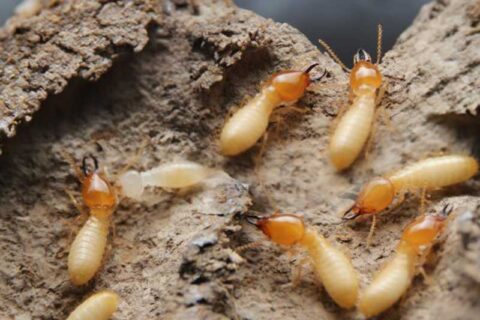Why Termite Control is Crucial in the Summer
Make no mistake about it: termites do not hibernate. These destructive creatures are busy all year round, destroying commercial and residential property across the nation to the tune of about $5 billion annually. That being said, termite control is particularly crucial in the summer.
Many homeowners don’t notice that they have a termite problem until they see the evidence, and evidence is abundant in summer. That’s when most species of termites swarm, leaving behind discarded wings on windowsills, in light fixtures, and so on. What you may not realize, when you see these wings around your property, is something chilling. Termites don’t swarm because they’re trying to establish a colony in your home, they swarm because their already-established colony has grown to its maximum size.
In a well-developed colony, you can expect to find about 300,000 termites. That means that by the time you notice them swarming, the termites already have hundreds of thousands of comrades in arms, munching away at your home. Why do they swarm? Termites reproduce quickly, and by the time they get to be about a year old, there are too many of them for the existing colony to sustain. That’s when the young termites, called alates, swarm out of their colonies in order to find places to build new colonies. Here’s the bad news for you: the swarmers whose wings you see in your home aren’t leaving your house for greener pastures. Rather, they’re working to establish a new colony in a different part of your property. If you ignore them, in a few summers you could have several colonies working on destroying your house. You may notice increased activity just after the last rains of spring, as the summer is beginning. After that, though, is when the real activity begins. Once the swarmers have found their new homes, they get to work in earnest. Termites are nothing if not industrious, and one colony can quickly forage a territory about an acre in size, chewing through over a pound of wood each day.
Of course, not every type of termite swarms in summer. While most species of subterranean termites swarm in the spring and summer months, drywood termites swarm during the late summer and fall months. Dampwood termites are also summer swarmers, but varying conditions can cause swarms to occur at different times. Sometimes these swarms are separated by weeks, while other times it’s merely days.
If swarming means your home is already infested with a large colony, are there signs that you can detect before it gets to that point? In short, yes. Subterranean termites can’t survive above ground, so their workers create mud tubes to carry them from the ground to the wood of the structure they want to devour. These workers don’t care for light, so look for their tubes in dark places. For instance, if your home is on a block foundation, look inside each pier. You might also find mud tubes in your crawlspace or on the exterior walls of your home. Other signs of an existing termite infestation in your house include droppings or frass, that can look like wood shavings, damage to wood inside your home, warped or buckling walls, ceilings, and floors, or bubbling, peeling paint.
A sharp-eyed homeowner can stay on top of the situation and identify signs of a termite infestation in the home. However, it’s always possible, because of the busy and unpredictable nature of everyday life, to miss something. If you fail to notice that termites have encroached on your premises, you could be in for some extensive, expensive repairs. A better course of action than looking for termites yourself is to schedule an annual termite inspection with an experienced professional inspector.
A professional termite inspector will discuss your property with you, taking care to determine the property history and your goals, before conducting the inspection. During an inspection, all the common entry points for termites will be checked for signs of termite activity. These entry points include the exterior foundation, basement or crawlspace, interior walls, and any place that the ground comes into contact with wood. Areas outside your home, like flower beds and wood patios, are also checked for signs of a termite infestation. The inspector will have a deep understanding of the kinds of termites that live in your area, as well as where to look for them and how to treat them. Once the inspection is complete, you’ll be given a detailed report, outlining the extent of the infestation and the best plan of action for ridding your home of existing termites and protecting it from further termite activity.
At MightyMite Termite Services, we’re experts in controlling all types of termites in California. We perform termite inspections to ensure that your home is free of termites and work hard to help you keep it that way, using treatments that are naturally derived and have a low impact on the environment. We diagnose and treat infestations with the most effective methods and unmatched warranties, solving your termite problems the first time, with an industry-best “no call-back rate.” That, combined with our experience, technology, and highly trained professional staff, makes us the leading extermination company in the Bay Area. We understand that your home is your most important investment, so we work hard to provide excellent service, utilizing best practices to solve our customers’ termite problems in Northern California. For more information, call us today at 408.335.7053, email Info@mightymitetermite.com, or contact us through our website.








